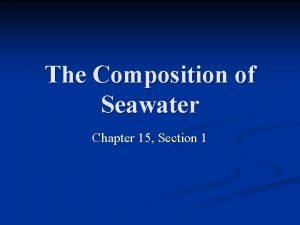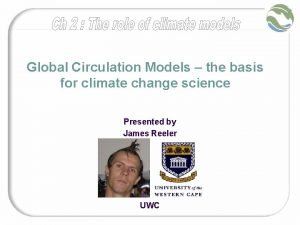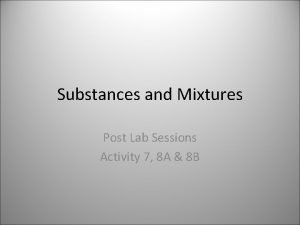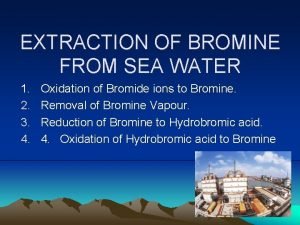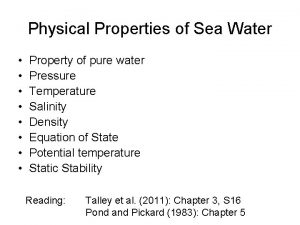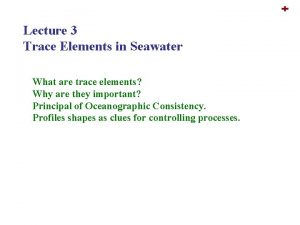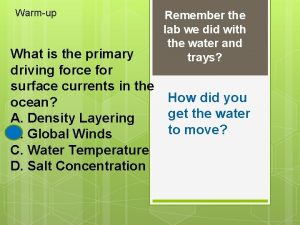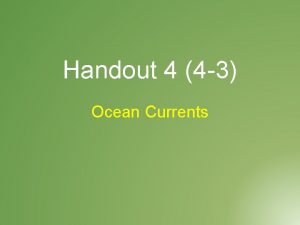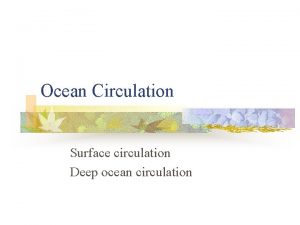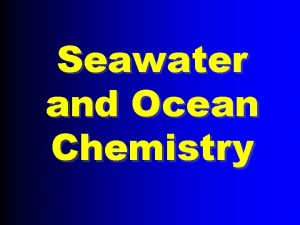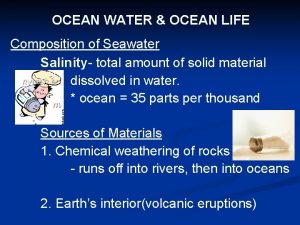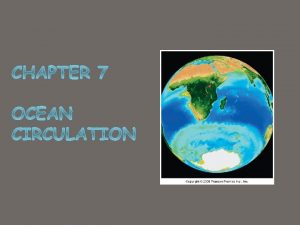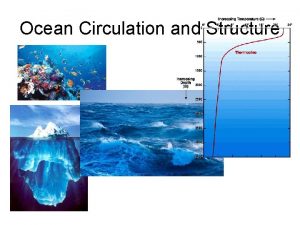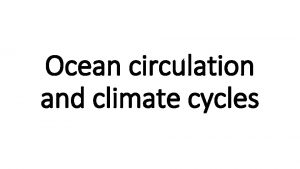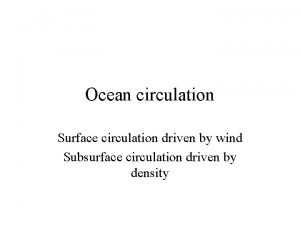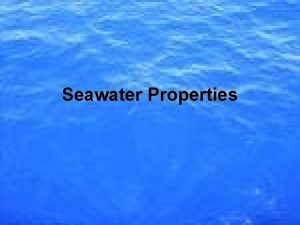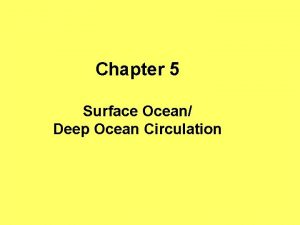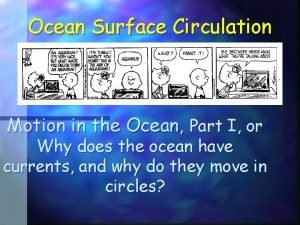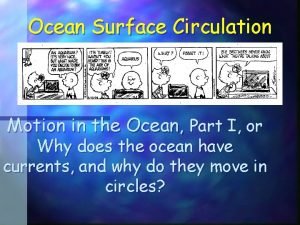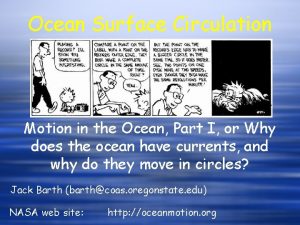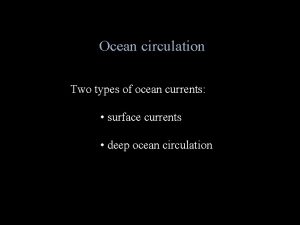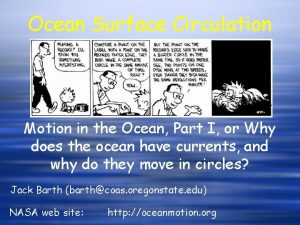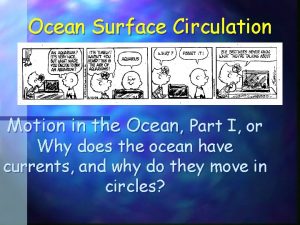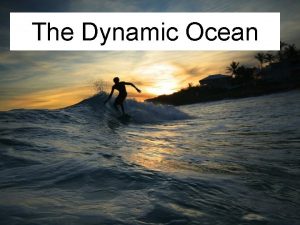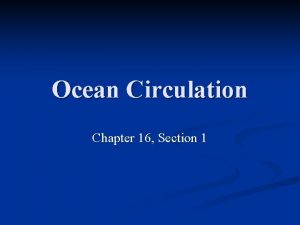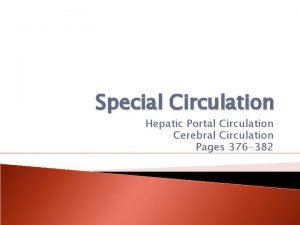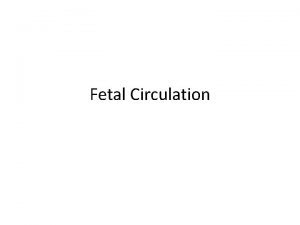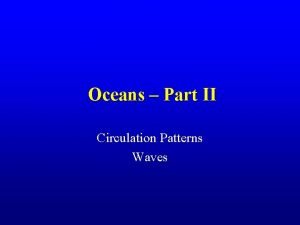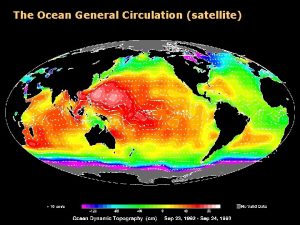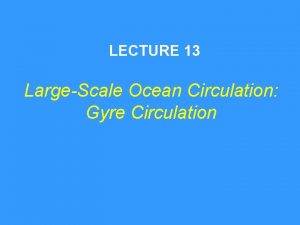13 The Composition of Seawater Surface Circulation Ocean





































- Slides: 37

13 The Composition of Seawater Surface Circulation Ocean current is the mass of ocean water that flows from one place to another. Surface Currents • Surface currents are movements of water that flow horizontally in the upper part of the ocean’s surface. • Surface currents develop from friction between the ocean and the wind that blows across its surface.

Ocean Surface Currents

13 The Composition of Seawater Surface Circulation Gyres • Gyres are huge circular-moving current systems that dominate the surfaces of the oceans. • The Coriolis effect is the deflection of currents away from their original course as a result of Earth’s rotation.

13 The Composition of Seawater Surface Circulation Ocean Currents and Climate • When currents from low-latitude regions move into higher latitudes, they transfer heat from warmer to cooler areas on Earth. • As cold water currents travel toward the equator, they help moderate the warm temperatures of adjacent land areas.

False-Colored Satellite Image of the Gulf Stream

13 The Composition of Seawater Surface Circulation Upwelling • Upwelling is the rise of cold water from deeper layers to replace warmer surface water. • Upwelling brings greater concentrations of dissolved nutrients, such as nitrates and phosphates, to the ocean surface.

Effects of Upwelling

13 The Composition of Seawater Deep-Ocean Circulation Density Currents • Density currents are vertical currents of ocean water that result from density differences among water masses. • An increase in seawater density can be caused by a decrease in temperature or an increase in salinity.

16. 1 The Composition of Seawater Deep-Ocean Circulation High Latitudes • Most water involved in deep-ocean currents begins in high latitudes at the surface. Evaporation • Density currents can also result from increased salinity of ocean water due to evaporation.

16. 1 The Composition of Seawater Deep-Ocean Circulation A Conveyor Belt • In a simplified model, ocean circulation is similar to a conveyor belt that travels from the Atlantic Ocean, through the Indian and Pacific Oceans, and back again.

Conveyor Belt Model

13 Waves and Tides Waves Wave Characteristics • Most ocean waves obtain their energy and motion from the wind. • The wave height is the vertical distance between the trough and crest. • The wavelength is the horizontal distance between two successive crests or two successive troughs.

13 Waves and Tides Waves Wave Characteristics • The wave period is the time it takes one full wave—one wavelength—to pass a fixed position. • Fetch is the distance that the wind has traveled across open water. • The height, length, and period that are eventually achieved by a wave depend on three factors: (1) wind speed, (2) length of time the wind has blown, and (3) fetch.

Anatomy of a Wave

13 Waves and Tides Waves Wave Motion • Circular orbital motion allows energy to move forward through the water while the individual water particles that transmit the wave move around in a circle.

13 Waves and Tides Waves Breaking Waves • Changes occur as a wave moves onto shore. • As the waves touch bottom, wave speed decreases. The decrease in wave speed results in a decrease in wavelength and an increase in wave height.

Breaking Waves

13 Waves and Tides are daily changes in the elevation of the ocean surface. Ocean tides result from the gravitational attraction exerted upon Earth by the moon and, to a lesser extent, by the sun. Tide-Causing Forces • The force that produces tides is gravity.

Tide Bulges on Earth Caused by the Moon

13 Waves and Tides Tide Cycle • Tidal range is the difference in height between successive high and low tides. • Spring tides are tides that have the greatest tidal range due to the alignment of the Earth– moon–sun system. • Neap tides are tides that have the lowest tidal range, occurring near the times of the first-quarter and third-quarter phases of the moon.

Earth–Moon–Sun Positions and the Tides

13 Waves and Tides Tidal Patterns • Three main tidal patterns exist worldwide: diurnal tides, semidiurnal tides, and mixed tides.

13 Shoreline Processes and Features Forces Acting on the Shoreline A beach is the accumulation of sediment found along the shore of a lake or ocean. Waves along the shoreline are constantly eroding, transporting, and depositing sediment. Many types of shoreline features can result from this activity.

13 Shoreline Processes and Features Forces Acting on the Shoreline Wave Impact • The impact of large, high-energy waves against the shore can be awesome in its violence. Each breaking wave may hurl thousands of tons of water against the land, sometimes causing the ground to tremble. Abrasion • Abrasion is the sawing and grinding action of rock fragments in the water. • Abrasion is probably more intense in the surf zone than in any other environment.

16. 3 Shoreline Processes and Features Forces Acting on the Shoreline Wave Refraction • Wave refraction is the bending of waves, and it plays an important part in the shoreline process. • Because of refraction, wave energy is concentrated against the sides and ends of headlands that project into the water, whereas wave action is weakened in bays.

Wave Refraction

13 Shoreline Processes and Features Forces Acting on the Shoreline Longshore Transport • A longshore current is a near-shore current that flows parallel to the shore. • Turbulence allows longshore currents to easily move fine suspended sand to roll larger sand gravel particles along the bottom.

Longshore Currents

13 Shoreline Processes and Features Erosional Features Shoreline features that originate primarily from the work of erosion are called erosional features. Sediment that is transported along the shore and deposited in areas where energy is low produces depositional features.

13 Shoreline Processes and Features Erosional Features Wave-Cut Cliffs and Platforms • Wave-cut cliffs result from the cutting action of the surf against the base of coastal land. A flat, bench-like, wave-cut platforms in front of the wave-cut cliff. Sea Arches and Sea Stacks • When two caves on opposite sides of a headland unite, a sea arch results. Eventually, the arch falls in, leaving an isolated remnant, or sea stack, on the wave-cut platform.

Sea Arch and Sea Stack

16. 3 Shoreline Processes and Features Depositional Features Spits, Bars, and Tombolos • Where longshore currents and other surf zone currents are active, several features related to the movement of sediment along the shore may develop. - A spit is an elongated ridge of sand that projects from the land into the mouth of an adjacent bay. - A baymouth bar is a sandbar that completely crosses a bay. - A tombolo is a ridge of sand that connects an island to the mainland or to another island.

Evolution of Shoreline Features

13 Shoreline Processes and Features Depositional Features Barrier Islands • Barrier islands are narrow sandbars parallel to, but separate from, the coast at distances from 3 to 30 kilometers offshore.

Barrier Islands

13 Shoreline Processes and Features Stabilizing the Shore Protective Structures • Groins, breakwaters, and seawalls are some structures built to protect a coast from erosion or to prevent the movement of sand along a beach. Beach Nourishment • Beach nourishment is the addition of large quantities of sand to the beach system.

Miami Beach Before and After Beach Nourishment
 Composition seawater
Composition seawater Single circulation and double circulation
Single circulation and double circulation Structure of bronchiole
Structure of bronchiole Single circulation and double circulation
Single circulation and double circulation Slowing atlantic ocean circulation
Slowing atlantic ocean circulation Ocean ocean convergent boundary
Ocean ocean convergent boundary Sciencechannel.com/activate
Sciencechannel.com/activate Convergent boundary
Convergent boundary Convergent oceanic oceanic plate boundary
Convergent oceanic oceanic plate boundary Ocean ocean convergent boundary
Ocean ocean convergent boundary Red ocean strategi
Red ocean strategi Types of divergent plate boundary
Types of divergent plate boundary Chapter 15 ocean water and ocean life wordwise answer key
Chapter 15 ocean water and ocean life wordwise answer key Boiling point of seawater
Boiling point of seawater Extraction of bromine from seawater equation
Extraction of bromine from seawater equation Colligative properties of seawater
Colligative properties of seawater Physical properties of sea water
Physical properties of sea water Trace elements in seawater
Trace elements in seawater What is the primary driving force of surface-ocean currents
What is the primary driving force of surface-ocean currents Surface ocean currents
Surface ocean currents High surface tension vs low surface tension
High surface tension vs low surface tension Curved surface area of cone
Curved surface area of cone How to get lateral surface area
How to get lateral surface area Hệ hô hấp
Hệ hô hấp ưu thế lai là gì
ưu thế lai là gì Tư thế ngồi viết
Tư thế ngồi viết Cái miệng nó xinh thế chỉ nói điều hay thôi
Cái miệng nó xinh thế chỉ nói điều hay thôi đặc điểm cơ thể của người tối cổ
đặc điểm cơ thể của người tối cổ Mật thư anh em như thể tay chân
Mật thư anh em như thể tay chân Bổ thể
Bổ thể Tư thế ngồi viết
Tư thế ngồi viết Thẻ vin
Thẻ vin Thể thơ truyền thống
Thể thơ truyền thống Các châu lục và đại dương trên thế giới
Các châu lục và đại dương trên thế giới Chúa yêu trần thế
Chúa yêu trần thế Từ ngữ thể hiện lòng nhân hậu
Từ ngữ thể hiện lòng nhân hậu Diễn thế sinh thái là
Diễn thế sinh thái là Vẽ hình chiếu vuông góc của vật thể sau
Vẽ hình chiếu vuông góc của vật thể sau
